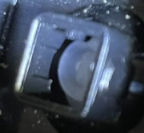I have an old Dell SK-8135 keyboard. I love it because it has a volume knob instead of buttons. I've used it so many years that it's the only keyboard I can touch type on without tons of errors. But one key I ALWAYS hit by accident on this keyboard is the CAPS LOCK key. So I had the brilliant idea to remove it.
I'm thinking I'd like to replace it with something with a smaller profile so maybe I won't accidentally hit it so often.
Question 1: Anyone know what to call this type of key? Each key has two little clips that hold them in.
And the socket has a channel for the clips:
The key works by pressing the white spongy layer below. I can activate it with a pencil.
Question 2: Any ideas for replacing this with something with a smaller profile? I don't think I can do anything to the existing key without destroying it. I put a little dowel in place, but it keeps falling out. I was thinking about trying to mold something with sugru, but I have never worked with it and I'm not sure how I'll keep that from falling out too. Whatever I do, I think it will either need something like the clips or just fit more snug.
I don't have a 3D printer or know anyone with one, so please don't suggest that! I doubt I can have a professional do anything under $20, which is all I'd be willing to spend on this. Otherwise, I'm sticking with a pencil for the next time I need CAPS LOCK!







